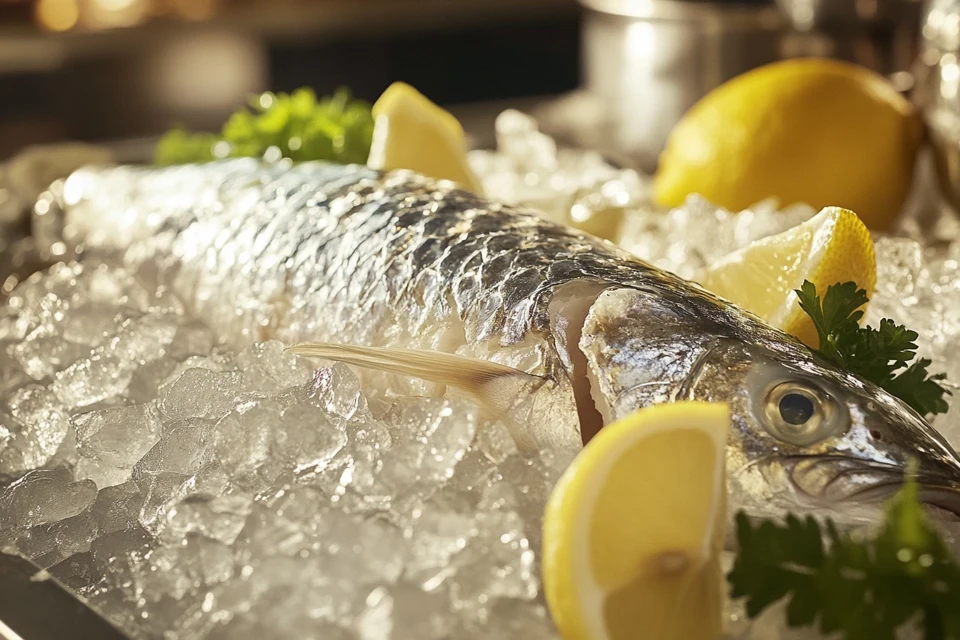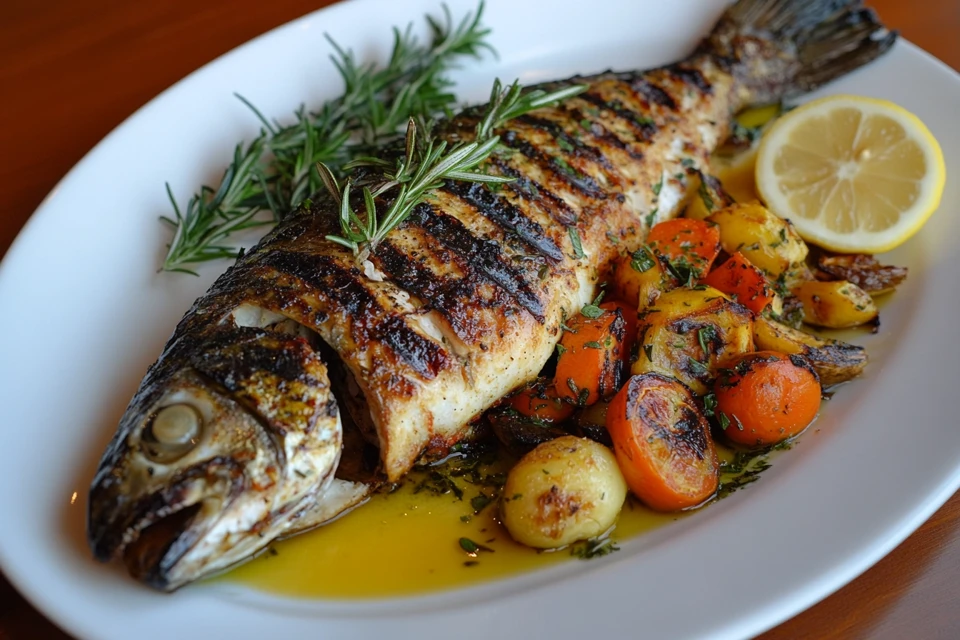1. Introduction
Branzino, also known as European sea bass, has emerged as a staple in kitchens and fine dining establishments worldwide. Its mild flavor and delicate texture make it an excellent choice for a variety of dishes. But beyond its culinary appeal, is branzino a good fish to eat?
This article dives into the nutritional benefits, culinary versatility, sustainability, and common concerns about branzino. Whether you’re considering adding it to your menu or simply curious about its place in the seafood world, this comprehensive guide has you covered.
2. What is Branzino: Is It a Good Fish to Eat?
To determine is branzino a good fish to eat, it’s essential to understand its origins, characteristics, and how it is cultivated. Branzino has a long-standing reputation in Mediterranean cuisine and is now a favorite in global seafood markets.
2.1 Branzino Overview: Why It’s Considered a Good Fish
Branzino, scientifically known as Dicentrarchus labrax, is a mild, white-fleshed fish that belongs to the sea bass family. It’s prized for its delicate flavor and versatility in cooking.
Key Characteristics:
- A mild, slightly sweet taste that complements a wide range of seasonings.
- Firm, flaky texture that holds up well to grilling, baking, and steaming.
- Ideal for whole fish presentations due to its manageable size and limited bones.
2.2 Habitat and Farming: Is Branzino a Sustainable Fish to Eat?
Branzino thrives in the Mediterranean Sea and Atlantic Ocean, particularly in coastal waters and estuaries. However, with growing demand, much of the branzino on the market today is farmed.
Wild-Caught vs. Farmed Branzino:
- Wild-Caught: Offers a firmer texture and stronger flavor but is less available due to overfishing concerns.
- Farmed: Widely produced in Greece, Italy, and Turkey, farmed branzino ensures consistent quality and supply.
2.3 Physical Characteristics: How to Identify Branzino?

Branzino is visually distinct, making it easy to identify:
- Size: Typically 1–3 pounds, though farmed varieties are usually smaller.
- Color: A shiny silver body with a darker dorsal fin.
- Shape: Elongated and sleek, ideal for cooking whole or as fillets.
Understanding these attributes can help you choose the freshest branzino at the market.
3. Nutritional Benefits of Eating Branzino: Is It a Good Fish to Eat?
Branzino is not only flavorful but also packed with nutrients that make it a healthy addition to your diet. When asking is branzino a good fish to eat, its nutritional profile provides a compelling answer.
3.1 Rich in Omega-3 Fatty Acids
Omega-3 fatty acids are essential for maintaining heart and brain health, and branzino is an excellent source of these healthy fats.
Health Benefits of Omega-3s in Branzino:
- Reduces the risk of cardiovascular disease by improving cholesterol levels and reducing inflammation.
- Supports cognitive function and reduces the risk of neurodegenerative diseases.
- Aids in joint health, making it beneficial for individuals with arthritis or other inflammatory conditions.
Compared to other popular fish like salmon, branzino provides a lighter option while still delivering significant omega-3 benefits.
3.2 Low Mercury Levels: A Safer Seafood Choice
Unlike larger fish such as tuna or swordfish, branzino has relatively low mercury levels.
Why Mercury Matters:
- High mercury levels in some fish can pose health risks, particularly for pregnant individuals and young children.
- Branzino’s low mercury content makes it safe for regular consumption, even for those with dietary restrictions.
This characteristic alone makes branzino an appealing choice for health-conscious consumers.
3.3 Source of Essential Nutrients
Branzino offers a range of vital nutrients that support overall well-being.
Key Nutrients in Branzino:
- Protein: High-quality lean protein for muscle repair and growth.
- Vitamin B12: Essential for nerve function and red blood cell production.
- Vitamin D: Supports bone health and immune system regulation.
- Selenium: Acts as a powerful antioxidant, protecting cells from damage.
Adding branzino to your diet ensures you get these essential nutrients while enjoying its mild, delicious flavor. Discover another nutritious dish in our Sinigang Recipe.
4. Culinary Appeal: Is Branzino a Good Fish to Eat?
The culinary versatility of branzino is one of its greatest strengths. Whether you’re a seasoned chef or a home cook, this mild-flavored fish adapts beautifully to a wide variety of cooking methods and flavor profiles. But is branzino a good fish to eat from a culinary perspective? Absolutely!
4.1 Flavor and Texture: Why Do People Love Branzino?
Branzino is prized for its clean, slightly sweet taste, which appeals to a wide range of palates.
Key Culinary Attributes:
- Mild Flavor: Its neutral profile makes it a perfect canvas for herbs, spices, and sauces.
- Firm Yet Flaky Texture: Holds its shape during cooking while remaining tender and moist.
- Adaptability: Pairs well with bold Mediterranean ingredients or subtle Asian flavors.
For those who appreciate simplicity in their meals, branzino is a go-to fish that delivers both flavor and elegance.
4.2 Popular Cooking Methods for Branzino

Branzino’s versatility allows it to shine in many different preparations, making it a favorite in diverse cuisines. For step-by-step instructions, explore this Branzino Recipe Guide.
Best Ways to Cook Branzino:
- Grilling: Whole branzino seasoned with olive oil, garlic, and lemon creates a smoky, charred flavor.
- Baking: Oven-baked branzino with Mediterranean vegetables offers a hearty, flavorful meal.
- Steaming: An Asian-inspired preparation with soy sauce, ginger, and scallions highlights its delicate flavor.
- Pan-Searing: Crispy skin and tender flesh make this a popular restaurant-style dish.
Each method brings out a unique aspect of the fish, making it an exciting ingredient to experiment with in the kitchen.
4.3 Why Chefs and Home Cooks Love Branzino
Chefs and home cooks alike favor branzino for its ease of preparation and reliable results.
Reasons Branzino Stands Out:
- Manageable Size: Perfect for serving whole without overwhelming portions.
- Minimal Bones: Simplifies the eating experience, making it ideal for filleting or serving whole.
- Consistency: Farmed branzino provides consistent quality, ensuring predictable outcomes in any recipe.
From elegant dinner parties to casual weeknight meals, branzino is a versatile choice that never disappoints.
5. Sustainability and Environmental Considerations: Is Branzino a Good Fish to Eat?
When considering is branzino a good fish to eat, sustainability plays a key role. With growing demand for seafood, understanding the environmental impact of farming and fishing branzino helps ensure responsible consumption.
5.1 Is Farmed Branzino Sustainable?
Farmed branzino has become the primary source of this fish in global markets, largely due to its sustainability.
Sustainability Benefits of Farmed Branzino:
- Reduced Overfishing: Farming reduces pressure on wild populations, preserving natural ecosystems.
- Efficient Practices: Modern aquaculture systems focus on minimal waste and improved feed efficiency.
- Reliable Supply: Farmed branzino ensures consistent availability without seasonal limitations.
When sourced from responsible farms, branzino offers a sustainable seafood option that meets environmental standards.
5.2 Environmental Impact of Wild-Caught Branzino
Wild-caught branzino, though prized for its flavor, poses challenges in terms of sustainability.
Key Concerns:
- Overfishing: Increased demand has led to population declines in some regions of the Mediterranean and Atlantic.
- Bycatch Risks: Non-target species may be unintentionally captured, disrupting marine ecosystems.
Solutions:
- Stricter fishing regulations and quotas help maintain healthy fish populations.
- Opt for certified wild-caught branzino to ensure responsible harvesting practices.
5.3 How to Choose Sustainable Branzino
Whether farmed or wild-caught, making sustainable choices is crucial when purchasing branzino.
Tips for Selecting Sustainable Branzino:
- Look for Certifications: Labels like MSC (Marine Stewardship Council) or ASC (Aquaculture Stewardship Council) indicate sustainable practices.
- Ask Your Fishmonger: Ensure the fish’s origin and production methods align with sustainability guidelines.
- Support Local Fisheries: Choosing locally sourced branzino reduces the carbon footprint associated with transportation.
By choosing responsibly sourced branzino, you can enjoy this delicious fish while supporting the health of our oceans.
6. Common Concerns About Eating Branzino: Is It Really a Good Fish to Eat?
While branzino is often celebrated for its flavor and versatility, some concerns may arise regarding taste preferences, cost, and health implications. Addressing these questions is crucial to fully understanding is branzino a good fish to eat.
6.1 Taste Preferences: Is Branzino Too Mild?
One common critique of branzino is its mild flavor, which some may find underwhelming.
Addressing the Concern:
- Why It’s Mild: Branzino’s neutral taste is intentional, making it ideal for pairing with bold seasonings and sauces. Similarly, learn how simple flavors differ in baked goods in our comparison of the Difference Between Croissant and Gipfeli.
- Enhancing Flavor: Use citrus, garlic, fresh herbs, or spicy marinades to bring out its best qualities.
For those who prefer robust flavors, branzino serves as an excellent base for creative culinary combinations.
6.2 Price Point: Is Branzino Worth the Cost?
Branzino is often perceived as a premium seafood option, which may raise questions about its value compared to other fish.
Factors Influencing Price:
- Farming Costs: Sustainable farming practices require investment in quality feed and controlled environments.
- Importation: For regions outside Europe, branzino’s price includes shipping and handling.
Why It’s Worth It:
- High-quality branzino offers a reliable texture, mild flavor, and nutritional benefits that justify the price for many consumers.
6.3 Health-Related Questions: Is Farmed Branzino Safe?
Some individuals express concerns about farmed fish, particularly regarding antibiotics or feed quality.
Myths vs. Facts:
- Antibiotics: Responsible farms adhere to strict regulations, limiting the use of antibiotics and ensuring safe consumption.
- Feed Quality: Advances in aquaculture include sustainable, high-quality feed that enhances the nutritional profile of farmed branzino.
Branzino remains a safe and nutritious choice when purchased from trusted suppliers.
7. FAQs About Branzino: Is It a Good Fish to Eat?
Here are some frequently asked questions to clarify whether is branzino a good fish to eat for your table and diet.
7.1 Is branzino a good fish to eat?
Yes, branzino is an excellent fish to eat due to its mild flavor, firm texture, and impressive nutritional benefits. Its low mercury levels and versatility in recipes make it a favorite for both health-conscious individuals and culinary enthusiasts.
7.2 How does branzino compare to other fish?
Branzino is milder than salmon and less buttery than Chilean sea bass, making it a versatile option for many recipes. Its low mercury levels and manageable size also set it apart from larger, predatory fish.
7.3 Is branzino safe for everyone?
Branzino is safe for most people, including pregnant individuals and children, thanks to its low mercury content. Always ensure the fish is fresh and sourced from reputable suppliers.
7.4 How do you cook branzino?
Branzino can be cooked whole or as fillets using methods like grilling, baking, steaming, or pan-searing. Mediterranean and Asian recipes often highlight its delicate flavor.
7.5 What should I look for when buying branzino?
Choose branzino with shiny silver skin, clear eyes, and a fresh, mild aroma. Look for sustainable certifications like MSC or ASC to ensure ethical sourcing.
8. Conclusion
So, is branzino a good fish to eat? Absolutely. Branzino stands out as a versatile, mild-flavored fish with a firm texture that appeals to a wide range of tastes. Its impressive nutritional benefits, including high omega-3 content and essential vitamins, make it a healthy choice for regular consumption.
Branzino’s adaptability in cooking—whether grilled, baked, or steamed—ensures it can be the star of countless recipes. Additionally, its low mercury levels and responsible farming practices add to its appeal as a sustainable and safe seafood option.
When choosing branzino, focus on fresh, sustainably sourced options to support ethical practices and enjoy the best quality. Whether you’re a seafood enthusiast or trying it for the first time, branzino promises a satisfying, nutritious dining experience.
